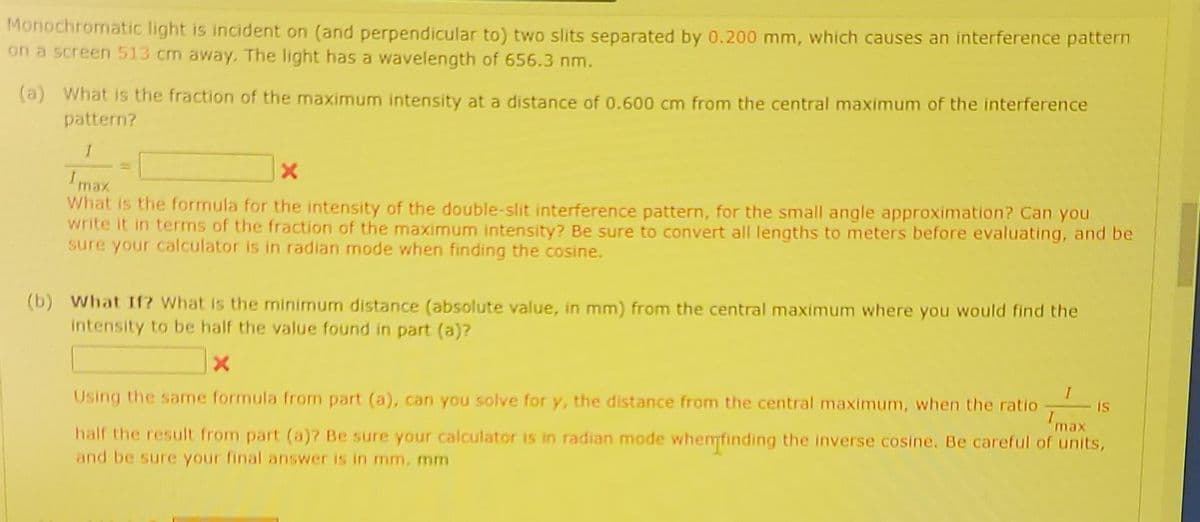Monochromatic light is incident on (and perpendicular to) two slits separated by 0.200 mm, which causes an interference pattern on a screen 513 cm away. The light has a wavelength of 656.3 nm. (a) What is the fraction of the maximum intensity at a distance of 0.600 cm from the central maximum of the interference pattern? What is the formula for the intensity of the double-slit interference pattern, for the small angle approximation? Can you write it in terms of the fraction of the maximum intensity? Be sure to convert all lengths to meters before evaluating, and be Imax sure your calculator is in radian mode when finding the cosine. (b) What If? What is the minimum distance (absolute value, in mm) from the central maximum where you would find the Intensity to be half the value found in part (a)? is Using the same formula from part (a), can you solve for y, the distance from the central maximum, when the ratio Imax half the result from part (a)? Be sure your calculator is in radian mode whemfinding the inverse cosine. Be careful of units, and be sure your final answer is in mm. mm
Monochromatic light is incident on (and perpendicular to) two slits separated by 0.200 mm, which causes an interference pattern on a screen 513 cm away. The light has a wavelength of 656.3 nm. (a) What is the fraction of the maximum intensity at a distance of 0.600 cm from the central maximum of the interference pattern? What is the formula for the intensity of the double-slit interference pattern, for the small angle approximation? Can you write it in terms of the fraction of the maximum intensity? Be sure to convert all lengths to meters before evaluating, and be Imax sure your calculator is in radian mode when finding the cosine. (b) What If? What is the minimum distance (absolute value, in mm) from the central maximum where you would find the Intensity to be half the value found in part (a)? is Using the same formula from part (a), can you solve for y, the distance from the central maximum, when the ratio Imax half the result from part (a)? Be sure your calculator is in radian mode whemfinding the inverse cosine. Be careful of units, and be sure your final answer is in mm. mm
Physics for Scientists and Engineers: Foundations and Connections
1st Edition
ISBN:9781133939146
Author:Katz, Debora M.
Publisher:Katz, Debora M.
Chapter35: Diffraction And Interference
Section: Chapter Questions
Problem 8PQ: Monochromatic light is incident on a pair of slits that are separated by 0.200 mm. The screen is...
Related questions
Question

Transcribed Image Text:Morniochromatic light is incident on (and perpendicular to) two slits separated by 0.200 mm, which causes an interference pattern
on a screen 513 cm away. The light has a wavelength of 656.3 nm.
(a) What is the fraction of the maximum intensity at a distance of 0.600 cm from the central maximum of the interference
pattern?
What is the formula for the intensity of the double-slit interference pattern, for the small angle approximation? Can you
write it in terms of the fraction of the maximum intensity? Be sure to convert all lengths to meters before evaluating, and be
Imax
sure your calculator is in radian mode when finding the cosine.
(b) What If? What is the minimum distance (absolute value, in mm) from the central maximum where you would find the
intensity to be half the value found in part (a)?
Imax
Using the same formula from part (a), can you solve for y, the distance from the central maximum, when the ratio
is
half the result from part (a)? Be sure your calculator is in radian mode whemfinding the inverse cosine. Be careful of units,
and be sure your final answer is in mm. mm
Expert Solution
This question has been solved!
Explore an expertly crafted, step-by-step solution for a thorough understanding of key concepts.
This is a popular solution!
Trending now
This is a popular solution!
Step by step
Solved in 3 steps

Knowledge Booster
Learn more about
Need a deep-dive on the concept behind this application? Look no further. Learn more about this topic, physics and related others by exploring similar questions and additional content below.Recommended textbooks for you

Physics for Scientists and Engineers: Foundations…
Physics
ISBN:
9781133939146
Author:
Katz, Debora M.
Publisher:
Cengage Learning

Principles of Physics: A Calculus-Based Text
Physics
ISBN:
9781133104261
Author:
Raymond A. Serway, John W. Jewett
Publisher:
Cengage Learning

University Physics Volume 3
Physics
ISBN:
9781938168185
Author:
William Moebs, Jeff Sanny
Publisher:
OpenStax

Physics for Scientists and Engineers: Foundations…
Physics
ISBN:
9781133939146
Author:
Katz, Debora M.
Publisher:
Cengage Learning

Principles of Physics: A Calculus-Based Text
Physics
ISBN:
9781133104261
Author:
Raymond A. Serway, John W. Jewett
Publisher:
Cengage Learning

University Physics Volume 3
Physics
ISBN:
9781938168185
Author:
William Moebs, Jeff Sanny
Publisher:
OpenStax

Glencoe Physics: Principles and Problems, Student…
Physics
ISBN:
9780078807213
Author:
Paul W. Zitzewitz
Publisher:
Glencoe/McGraw-Hill